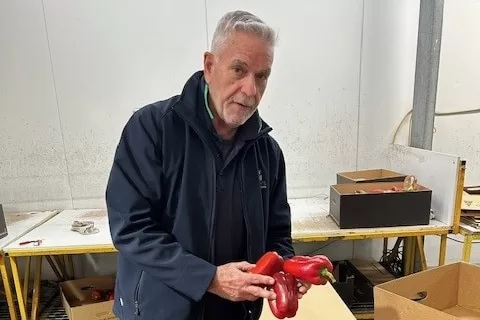- In short: Fresh produce coming out of one of South Australia’s major growing regions is subject to measures to eradicate fruit fly.
- Certain produce being grown and handled in the Northern Adelaide Plains must be fumigated before heading to supermarkets, adding time and cost.
- What’s next? Supply should become more certain and prices expected to come down for produce like capsicum as more arrives from Queensland.
A small but damaging fruit fly outbreak in a key South Australian food bowl is contributing to national delays and pushing prices for supermarket produce to levels unseen by wholesalers.
Fruit fly control measures north of Adelaide mean some fruits and vegetables must be fumigated before they reach consumers, causing some growers to sell their produce interstate instead.
Kingsley Songer is general manager of 4 Ways Fresh Produce at Virginia, which both grows and wholesales produce such as capsicum, eggplant and zucchini for other growers to major supermarkets.
He said the fumigation process was adding to handling times and costs.
“Capsicum coming in from Queensland generally has to be fumigated anyway, but this year because we’ve got issues with fruit fly even some of the fruit that normally is not having to be fumigated this year, depending on how it’s handled, might have to be fumigated [anyway],” Mr Songer said.
“That’s just added to the issue as far as price is concerned, because once you start fumigating any sort of product, you’ve got the cost of the process, plus you get more issues with the fruit quality as well.”
Fumigation challenges for fruit
He said capsicum doesn’t handle fumigation “particularly well”, causing higher losses.
It also had to be carried out at a certain temperature.
“Then you’ve got to cool it back down again before you can send it to the supermarket because they won’t take delivery of it at that sort of temperature, so it does add to your handling costs,” he said.
“It adds to the time delay getting the fruit from the growers in the supermarkets.”
Mr Songer said some growers had chosen to sell produce interstate to avoid the “muck around” required to sell into SA.
“This has caused a problem with shortages in SA because a lot of fruit that would normally be sold in SA has wound up in the eastern seaboard because they don’t have to get the capsicum fumigated in NSW and Victoria,” he said.
Fruit fly outbreaks remains a concern
The outbreak was triggered in early March when six fruit flies were detected in Salisbury North.
General manager of Fruit Fly Emergency Response at the Department of Primary Industries and Regions, South Australia (PIRSA) Con Poulos said only one more fly had been found this past month, with the restrictions on track to be lifted on November 13 unless more were detected.
“One of the key priorities for PIRSA, obviously, is eradicating fruit fly [but] another priority is allowing fruit movement with commercial growers,” Mr Poulos said.
“We need the economy to function.
“We still want all that beautiful produce to get back into metropolitan Adelaide and other areas, so there’s certain treatments and assurance programs that we work through with growers that will allow that movement and satisfy the secure movement as well.”
Red capsicum costs soar
As the main growing season for produce like capsicum comes to an end in SA, Queensland takes over supply.
Mr Songer said that has been delayed this year because of wet conditions.
“We supply the eastern seaboard — SA, Victoria and NSW predominantly — even some into Queensland during our summer,” he said.
“Then when we start to get towards winter we start to see less coming out of SA and more starting to come in from the other states, particularly Queensland.
“We normally would be well into the Queensland [capsicum] crop by now, but we’re just seeing it starting to pick up.”
All these factors have pushed wholesale red capsicum prices up to $10 per kilogram.
“It’s not cheap – it’s probably as expensive as it’s ever been right now, certainly in my time in the game,” Mr Songer said.
“You’ve seen the supermarkets now starting to draw the line at that $95 to $100 a box, so we’re in that state of flux at the moment where … if you want the product, that’s what it’s going to cost.
“That will start to come back as we see more product coming in from Bundaberg and that North Queensland area.”
